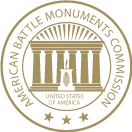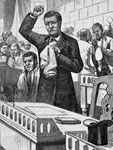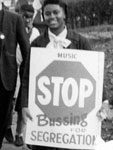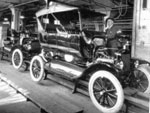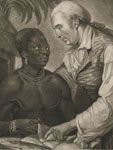This first document is a telegram from Dr. Martin Luther King Jr. to the Jackie Robinson Testimonial Dinner acknowledging that he was not going to be able to attend. The reason being he was going back to Albany, GA. The telegram was sent to Reverend Wyatt Walker, who was his strategist for most of the civil rights-era movements and trying to strategize about the nonviolent approach to the civil disobedience strategy they were putting together.
King could not attend this dinner. In fact, King was one of the coordinators of the dinner. He was helping a number of people acknowledge the significance of Jackie Robinson's contribution. The fact that he was being inducted into Baseball's Hall of Fame three days later was important because, again, Robinson was the first African American to play in the major leagues in the modern era. Those that played—the last group of African Americans that played played in the 1880s; so Robinson becoming the first integrated baseball [player] in 1947 was significant. Reason being, he was the first to demonstrate this idea of integration in a public way. His baseball play on the baseball field was a demonstration of the ability of African Americans to persevere. The things that he was able to achieve, the things that he endured made him an example for people like Dr. King; it was an example for young men like an Arthur Ashe. So this Testimonial Dinner was to acknowledge his accomplishments.
Just in thinking about this telegram [from] King, the language used—and again this is a telegram so you can't put everything you want in there, it has to be short and concise. King writes:
Warmest heartfelt greetings to all of you assembled on this auspicious occasion. An important turn of events in Albany, GA, made it imperative for me to return here immediately. Had looked forward with great anticipation to being with you tonight. Can think of nothing I regret more than having to miss this opportunity to personally join with you in this testimonial to one of the truly great men of our nation. —Martin Luther King Jr.
So in this document you have someone like King, and even in '62, he is still elevated as being this significant individual, that he would acknowledge Jackie Robinson as being this really great man. And so would I ask my students, or I would ask even myself, what qualities did Jackie Robinson demonstrate that King thought were so important to identify him as this great man?
I think in our nation when we [think] about great men we think about our Presidents. So to have Robinson at the top of that pile of men or that mountain of individuals is something to imagine. In my mind, what qualities, what characteristics does someone like a "Robinson" have that would call for his identification as a great man?
I would say that because of Robinson's perseverance, because of the strength of character he demonstrated when he was playing baseball, when he was receiving the catcalls, when he was being taunted by opposing pitchers or managers at the dugouts. He demonstrated the kind of character that King would also take advantage of or use in his own nonviolent civil disobedience or his way in which he demonstrated his own character. And so Robinson became an example for children, for adults; he was in some ways—not even I would call him the poster child, but he was the example that a number of African Americans looked to as they themselves sought to—not integrate society—but to be recognized as human beings and as citizens of the United States.
Even with baseball, I would say that it's less about sports, and it's more about demonstrating one's…not autonomy, but one's humanity. So, the fact that you have it in an arena where people are watching makes it important because there are those who are there to validate what you're doing. So it's not necessarily the fact that Robinson could hit a home run, it's the fact that he's able to compete with white men and had the opportunity to do so. So it's less about the sport, it's more about what it says about his abilities as a human being; and therefore he becomes a metaphor for other African Americans or other minorities or other people who are marginalized. So it becomes a performance.
It's July 20, 1962. So King wrote this keynote address to present Jackie Robinson to these 800-plus people at the Waldorf Astoria on the occasion of him being inducted into the Hall of Fame. It's a very interesting address in that he accounts for the changes taking place in the nation, his push in Albany, GA, to integrate the society, and how he is serious about the changes that need to take place. This is something that he mentions in the first few pages of the document. What I find really important about the document is the discussion about Jackie Robinson's mother. And this is research that people really have neglected as it relates to how does Robinson learn about integrating society, what examples does he have? So the idea that King himself acknowledges Mallie Robinson, Jackie Robinson's mother, her contribution, is something I think is really important. That's an important part of this document.
This is the letter here, it says:
It seems particularly fitting that the latest battle in the holy war for freedom has its locale in the state of Georgia. Jackie Robinson was born in that state and the indomitable spirit which is characteristic of heroic Negro women of the South is the same stripe of courage and integrity which marks Mallie Robinson, Jackie's mother, who sits with us tonight. We are certain that the mother of our guest of honor is content in the realization that the vision she cherished was not nursed in vain. It was the vision of a woman, who, without help, had to bring a family out of the bleak shadows of the sharecropper's life into the sunlight of new opportunity in the Far West. This is Jackie Robinson's night, but he, himself, would be the first to tell you that you cannot declare a night in his honor without also honoring the two women who have been his inspiration and his strength: Mallie Robinson, his wonderful God-fearing mother, and Rachel Robinson, his wife, companion, his solace and full partner in moments of despair as well as moments of triumph.
This is such a powerful testimony to him not doing it on his own, but Robinson being groomed within the context of the early 20th century by his mother, who is sharing this formula to—not just being successful, but for identifying yourself as being a human being, deserving of the rights of full citizenship. Which I think is amazing.
This is just one part of this—of these documents that I would even have students do more research on. In what way was she an inspiration? How did she demonstrate this way in which to win people over? Is it through her kindness? Did she demonstrate on the block—how you convince people of your humanity? What was her formula, what was her technique? That brings up another question too—the role of women within black communities. It's this—new history is uncovering the fact that black women represented these "outsiders within." They were the domestics who worked in white communities who traversed those lines of discrimination and brought back information to their families.
So similar to Jackie Robinson and his mother Mallie, you have Ralph Ellison's mother, who worked as a domestic who brought information from outside of the community into the community. So these mothers, these women, these contributors to this community were really bringing much more to the community besides their ability to earn an income. They were bringing this knowledge that could, and did, inspire the next generation to continue to fight for their rights. And Robinson is just one example. I would say that Joe Louis has the same thing in the 1920s when his family moves to Detroit, along with Jesse Owens, the same thing in Cleveland. These are the people we've identified as being significant because of their accomplishments. What about those that we do not know about that have also contributed greatly to increasing the opportunities for not just African Americans, but for all people who've been marginalized?
The third document is the actual seating list for the Hall of Fame dinner. It's taking place on July the 20th, 1962, at the Waldorf Astoria Hotel in New York. At the head table you have people like, for instance, Whitney Young, who was a civil rights activist. You have—if you look down the list, you have the entire Robinson family and friends; you have the heavyweight champion Floyd Patterson, who's there with family and friends; you have of course Duke Ellington, who is the jazz—jazz royalty, if you will. And then you can go on down the list and find different names that maybe jump out. But I guess what's most important about this is the range of people who are in attendance. It's not just political. There are people who support the idea of a movement; not just a civil rights movement, but this human rights movement. This idea that here is someone who we've come to honor, of what he's not only been able to achieve as a baseball player—that's only one aspect of his life—but he has done for American people, for oppressed people. He's demonstrated that one person can make a difference. In doing that, they're there to honor him for that.
He grew up in a neighborhood that was integrated by his family, but he was still ostracized and tormented because he was black. He used his athletic ability that he developed as a child to overcome those differences. The fact that he was able to become such a wonderful athlete at UCLA, that's only one thing. But he used that; he channeled his anger and his frustration into—in baseball into base hits, into touchdowns, into home runs. He was able to take something that was a day-to-day kind of experience [with] racism and being separate from society and use it to his advantage. He refused to participate in the Jim Crow society that the black players in the Negro leagues were accustomed to. He refused to eat out of the paper bags that were handed to them with sandwiches; he said, "If we're going to buy your gas, we're going to be able to use your restaurant. And we're going to use your restroom if we need to." And so he challenged the status quo, and some people didn't like that because they felt that he thought he was better than them, when in fact he was demonstrating what his mother had demonstrated to him: that you're a human being [and] you have the right to be treated as such.
What I do when I'm teaching about certain time periods in history—or at least events—we'll say events—what I have my students do is to deconstruct the event. Give me some of the major things that occurred that led to that event unfolding. Let's name them. And let's see, what are some of the unintended consequences that came out of these different combinations of factors, because those things were not anticipated.
The fact that Robinson's mother chose to move to California as opposed to Detroit, New York, Cleveland, Kansas City, that gave him a different opportunity that could not be predetermined. No one could imagine the fact that she brought him up in an integrated neighborhood where she herself was the example was going to be the "x factor" as relates to Jackie Robinson in some ways becoming that person. But these other factors had to also play out. He had to go to UCLA, he had to play on integrated teams at Pasadena Junior College, he had to meet Joe Louis at Fort Riley, and Joe Louis had to become heavyweight champion and garner the love of a nation with his fights with Schmeling in 1938. So, all these other things we couldn't anticipate—things had to unfold the way they did and people had to anticipate opportunity and take advantage of when it came. But there is no way we could have ever have guessed Jackie Robinson would become the person he was, the person we still admire.
It's hard for me in some ways to teach history in this kind of chronological kind of fashion. By date it may work that way, hour-by-hour, but there are things that precede that moment that kind of set up the opportunity for something to unfold differently than you've maybe anticipated. What I like to do is draw a timeline—yes, these things happened, this is the date, but what happened over here or over here that primed us to take advantage of the moment when it arises, when it arose. That's kind of the way in which I approach these different historical moments.
With Robinson, no one really knows he was in a little gang when he was a kid, the Pepper Street Gang. Some of the information that I've read says that he was the leader of this little gang. They weren't a violent gang—they stole apples, they ran through cherry orchards and pulled cherries off of trees, things of that nature. But one person in his neighborhood said, "You're going down the wrong road, young man." And that one person probably made a big difference in his life. So, it really matters when we think about how these things unfold, it matters who the people are in our lives. It could be that one thing that changes everything. Robinson has enough people in his life helping him make decisions, so that when he has to make choices on his own, he's making them within the context of moving forward. Even though there are challenges and obstacles that will arise.
There's not one way in which to lead people, there are multiple ways to freedom. And I think that both of these individuals [Jackie Robinson and Martin Luther King Jr.] juxtapose against one another. They demonstrate that. One of course does it in baseball—but it's not really about baseball—and one of course does it in marching, but it's not about marching. They're these demonstrations of one's ability to claim your humanity, your manhood, and your citizenship. You just happen to have an audience watching you.
I think Jackie Robinson is underappreciated for his civil rights, not just record, but his significance. And when we think about this idea of integrating baseball we've reduced it just to that, just to baseball. When in fact he is such a huge figure, and the ability of an individual to stand up not only for what he believes in, but for what he believes other people want him to believe in—or to represent. Robinson himself is initiating a lot of these integration [and] these conversations about integration through his athletic competition; but what he's doing more than anything else, he's challenging his right to speak up as a human being and as an American citizen. So, when you have Dr. King and Jackie Robinson coming together, and you put those two individuals in the same room, who's learning from who? Is King learning about, not necessarily civil disobedience, but how to be patience? Is he learning more compassion? Is he learning the techniques? Because Robinson got it from the best of them when he was playing baseball; he received the death threats, which King would receive later on in his life. So, at what point can we say that they both learned from one another? And Robinson, in fact, maybe inspired even more because he knew the way he had gone through it, he had run the gauntlet.
